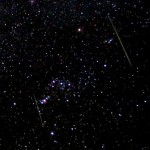The Perseids are one of the most watched meteor showers. Occurring during northern hemisphere summer, the shower can be appreciated on a summer night. Quite a difference from the other reliable showers such as the Leonids and Quadrantids, that occur in November and January. Consider a warm summer night under a dark sky full of stars, a picnic blanket, relaxing while shooting stars streak across the sky. What could be better?
The Perseid meteor shower occurs when the Earth passes through a stream of debris along the orbit of Comet Swift-Tuttle. This shower has been consistent throughout recorded history, mentioned in Chinese, Japanese and Korean records as early as the 1st century. Active from July 17th to August 24th, the shower will build slowly for weeks before the peak. A week before or after peak the shower can still be seen with around 20 meteors each hour. The shower is a northern hemisphere event, for southern observers the radiant never rises above the horizon.

Stargazing on Hawai’i
Here on the Big Island the single best place to stargaze is the Mauna Kea VIS. The dark skies are usually free of clouds and are well away from the lights of Hilo and Kona. After dark use for stargazing is not only permitted, but encouraged. It can be cold at 9,200ft, bring warm clothes and blankets
The Perseids produced strong activity from an unexpected primary maximum throughout the 1990s, associated with the perihelion passage of their parent comet, 109P/Swift-Tuttle, in 1992. The comet’s orbital period is about 130 years. Further enhanced activity ahead of the usual maximum was last seen in 2004. Recent IMO observations (see HMO p.145) found the timing of the mean or ‘traditional’ broad maximum varied between λ⊙∼139.8◦ to 140.3◦, equivalent to 2013 August 12, 13h15m to August 13, 01h45mUT. No additional peaks are anticipated this year, but this does not guarantee what will occur! – From the IMO 2013 Shower Calendar
The traditional peak is predicted to occur from 18:15 to 20:45UT on August 12th. This converts to 08:15 to 10:45HST on the morning of August 12th for Hawaiian observers, thus occurring after sunrise. The text quoted above notes that some peaking can occur a few hours earlier. Thus best viewing for the US west coast and the central pacific should occur during the predawn hours of the 12th. Viewers attempting to watch during the evening hours should stay up late as the radiant will rise about 10pm, starting the show. With a thin crescent Moon setting in the early evening hours, moonlight will not spoil viewing for the 2013 event.
Before 10pm, when the radiant is still low in the sky, keep an eye out for Earth-grazers, meteors that encounter the atmosphere at a low angle. Often these low angle meteors can streak across much of the sky, creating a spectacular event. The low angle allows the meteor to skim through the thin upper atmosphere without encountering thicker air and a quick demise. Do not expect a lot, but if you are lucky you may see one or two.
Watching meteors requires no more equipment than your eyes and a dark sky, and can be enjoyable for just about anyone. A good meteor shower is a great excuse to get out under a dark sky and enjoy the stars. Conditions should be quite good, why not make a point to watch the Perseids this year?

